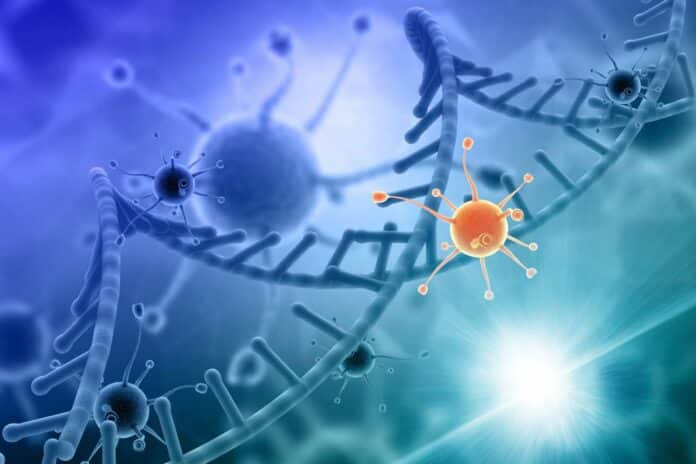A liquid biopsy for tumor analysis is a method that allows for noninvasive access to tumor-related information by using a simple blood draw instead of a surgical procedure. This approach is advantageous because it can detect tumor DNA even when the tumor’s exact location is unknown. However, circulating tumor DNA is typically present in low amounts, making it challenging to collect enough blood for reliable detection, especially in small tumors.
A team of researchers from MIT, the Broad Institute of MIT, and Harvard has developed a method to enhance the detection of tumor DNA in the bloodstream by temporarily slowing down the removal of circulating tumor DNA.
They created two injectable molecules, called “priming agents,” that can briefly disrupt the body’s ability to clear tumor DNA from the bloodstream. In experiments with mice, these agents increased DNA levels enough that the detectability of early-stage lung metastases rose from less than 10 percent to over 75 percent.
This technique can potentially enable earlier cancer diagnosis, improve the sensitivity of detecting tumor mutations for treatment guidance, and enhance cancer recurrence detection.
Liquid biopsies are currently employed in many cancer patients to identify mutations that can guide treatment decisions. The ongoing efforts to enhance the sensitivity of liquid biopsies have primarily concentrated on developing advanced sequencing technologies for use after blood collection.
While brainstorming ways to make liquid biopsies more informative, researchers proposed increasing the amount of DNA in a patient’s bloodstream before the sample is taken.
The body employs two main strategies to eliminate circulating DNA from the bloodstream. Enzymes called DNases circulate in the blood, breaking down encountered DNA, and immune cells known as macrophages uptake cell-free DNA as blood passes through the liver.
In this study, the researchers focused on independently targeting each of these processes. To hinder DNases from breaking down DNA, they developed a monoclonal antibody. This antibody binds to circulating DNA, shielding it from the enzymes and preventing degradation.
J. Christopher Love, the Raymond A. and Helen E. St. Laurent Professor of Chemical Engineering at MIT, said, “Antibodies are well-established biopharmaceutical modalities, and they’re safe in several different disease contexts, including cancer and autoimmune treatments. The idea was, could we use this kind of antibody to help shield the DNA temporarily from degradation by the nucleases that are in circulation? And by doing so, we shift the balance to where the tumor is generating DNA slightly faster than is being degraded, increasing the concentration in a blood draw.”
The second priming agent created by the researchers is a nanoparticle specifically designed to inhibit macrophages from absorbing cell-free DNA. This nanoparticle takes advantage of the fact that macrophages tend to engulf synthetic nanoparticles.
Sangeeta Bhatia, the John and Dorothy Wilson Professor of Health Sciences and Technology and Electrical Engineering and Computer Science at MIT, said, “DNA is a biological nanoparticle, and it made sense that immune cells in the liver were probably taking this up just like they do synthetic nanoparticles. And if that were the case, which it turned out to be, then we could use a safe dummy nanoparticle to distract those immune cells and leave the circulating DNA alone so that it could be at a higher concentration.”
The scientists tested their priming agents in mice with transplanted cancer cells that typically form lung tumors. Two weeks after the cell transplant, the priming agents increased the circulating tumor DNA in a blood sample by up to 60 times.
After taking a blood sample, it can undergo the same sequencing tests used in liquid biopsies. These tests can identify tumor DNA, helping determine the type of tumor and potential treatment options.
For early cancer detection, the nanoparticle priming agent allowed them to detect circulating tumor DNA in 75% of mice with low cancer levels, compared to none without the boost.
After injecting either of the priming agents, it takes about an hour or two for the levels of DNA to increase in the bloodstream. However, these elevated levels return to normal within approximately 24 hours.
Love said, “The ability to get peak activity of these agents within a couple of hours, followed by their rapid clearance, means that someone could go into a doctor’s office, receive an agent like this, and then give their blood for the test itself, all within one visit. This feature bodes well for the potential to translate this concept into clinical use.”
Journal Reference:
- Martin-Alonso, C., Tabrizi, S., Xiong, K., Blewett, T., Sridhar, S., Crnjac, A., Patel, S., An, Z., Bekdemir, A., Shea, D., Wang, T., Rodriguez-Aponte, S., Naranjo, C. A., Rhoades, J., Kirkpatrick, J. D., Fleming, H. E., Amini, A. P., Golub, T. R., Love, J. C., Adalsteinsson, V. A. (2024). Priming agents transiently reduce the clearance of cell-free DNA to improve liquid biopsies. Science. DOI: 10.1126/science.adf2341
